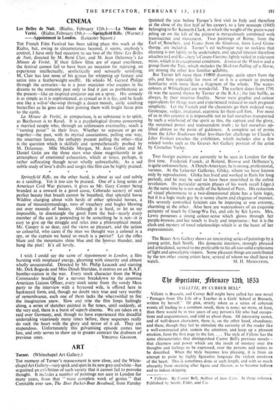ART
Turner. (Whitechapel Art Gallery.) THE moment of Turner's reassessment is now close, and the White- chapel Art Gallery—very spick and span in its new grey and white—has organised an exhibition of such variety that it cannot fail to provoke thought. It includes a number of paintings not seen in London for many years, from that " most complete work of genius " that Constable ever saw, The Dort Packet-Boat Becalmed, from Fawley (painted the year before Turner's first visit to Italy and therefore at the close of the first half of his career), to a late seascape (1845) belonging to Sir Kenneth Clark, in which the weight of the green water piling up on the left of the picture is miraculously combined with translucence and movement. Two paintings of Rome, from the Earl of Rosebery, and Venice from the Giudecca, from Lord Grim- thorpp, are included. Turner's oil technique was so reckless that cleaning is not lightly to be undertaken, and special interest therefore attaches to Lord Ru .ebery's Campo Vaccino, lightly veiled in iridescent mists, which is in exceptional condition. Jessica at the Window and a group from the Tate, which includes the Skeleton Falling off a Horse, are among the other less familiar. -ax,tibits.
But Turner left more than 19;000 drawings, quite apart from the
oils, and here especially for most of us it is a conceit to pretend familiarity with more than a fragment of the whole. The water- colours at Whitechapel are wonderful. The earliest dates from 1791 (it was the second shown by Turner at the R.A.) ; the late baffle, as always, by their intuitive finality. Never were graphic and colour equivalents for things seen and experienced reduced to such pregnant simplicity. Let the French and the classicists go their ordered way. Grotesque, vulgar, irrational, eccentric let them call him. For most of us in this country it is impossible not to feel ourselves transported by such a whirlwind of the spirit as this, the rapture and the glory, the sustained power and transcendent truth ; to feel ourselves up- lifted almost to the point of giddiness. A complete set of prints from the Liber Studiorum (that less-than-fair challenge to Claude's Liber Veritas) enriches the exhibition, which includes also a few related works such as the Graves Art Gallery portrait of the artist by Cornelius Varley.
•
Two foreign painters are currently to be seen in London for the first time. Frederick Franck, at Roland, Browse and Delbanco's, is quite unknown here. A Dutch-American, he is strong, professional, various. At the Leicester Galleries, Ghika, whom we have known only by reproduction. Ghika has lived and worked in Paris for long periods, and he may be said to have been nourished in the cubist revolution. (In particular certain phases of his work recall Leger.) At the same time he is not really of the School of Paris. His reduction of visual phenomena to a two-dimensional plane has a latin logic, but it is a logic made gay by a sunny charm and elegance of manner. His severely controlled lyricism can be imposing at one extreme, charming at the other. Also here are watercolours of an exquisite certainty of touch by Cheng-Wu Fei, and oils by Kit Lewis. Mrs. Lewis possesses a strong colour-sense which glows through her purple-browns, and her touch is lively and impetuous ; but it is the clash and mystery of tonal relationships which is at the heart of her expressionism.
*
The Beaux Arts Gallery shows an interesting series of paintings by a young artist, Jack Smith. His domestic interiors, strongly phrased and articulated, seemed to me preferable to his all-too-solid explosions of light and apocalyptic visions. Some pleasant things are contributed by the ten other young artists here, several of whom we shall have to


































 Previous page
Previous page